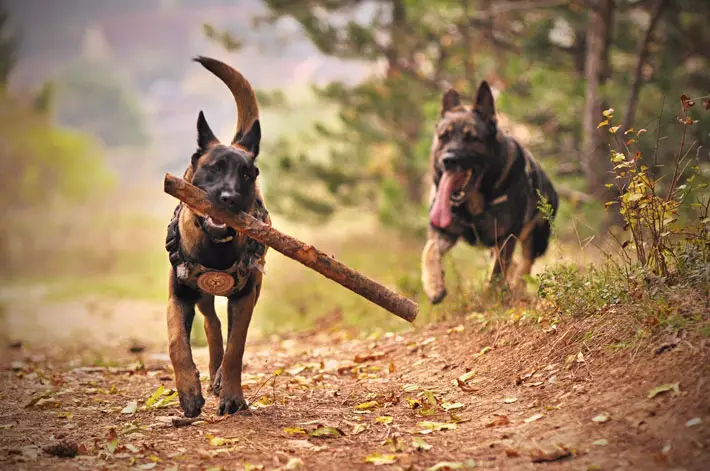Everything You Need to Know About Joint Health for Dogs

If your canine companion is anything like other dogs, you know that they’re willing to jump through hoops for you. They certainly have the energy. From endless tennis ball hunts to spectacular displays of excitement, dogs are experts at staying active. Granted, that doesn’t mean our sprightly pets aren’t prone to losing some of the spring in their step.
The effects of old age on dogs are similar to those experienced by their owners. Joint problems are especially common.
Take osteoarthritis or degenerative joint disease, for example. According to the Royal Veterinary College (RVC), the issue is prevalent among 37% of UK pet dogs. That’s over one third of the national canine population. Lameness and patellar luxation affect 17% and 12% of dogs respectively. Other musculoskeletal disorders include:
● Cruciate disease
● Hip dysplasia
● Stiffness
● Spinal pain
● Recumbency (hesitance to move)
Even with the utmost amount of care, no dog is immune to these health risks. Joints are naturally worn down by years of regular and often intensive use. Taking preventative measures and learning about available treatments is the best thing you can do for your pup’s precious joints. Here’s everything you need to know.
While traditional treatments for joint problems in dogs, like pain relief medications, are common, innovative therapies are emerging, such as the arthritis injections for dogs offered by Stem Cell Vet UK, providing a more advanced approach to managing arthritis and other joint-related issues in our canine companions
Understanding Joints
Let’s start by brushing up on the basic components of a joint and their functions.
● Cartilage is a connective tissue that dampens the impact of movements
● Synovium and synovial fluid lubricate bones to help them glide freely
● Ligaments serve as connective fibres that prevent bones from dislocating
When cartilage is worn away or damaged by injuries, nothing is left between bones to stop them from colliding. This leads to pain and inflammation. Cartilage is more susceptible to deterioration if synovial fluid levels are low.
Risk Factors and Causes
There are several risk factors for canine joint problems. As you can probably guess, age is foremost. Weight, trauma, gender and breed can also contribute to varying degrees. Large breed dogs tend to be bigger targets, possibly due to genetic predisposition or increased weight and rapid ageing. Some joint issues are breed-specific. For instance:
● Bulldogs and Boykin Spaniels are at risk of hip dysplasia
● Newfoundlands experience cruciate ligament disease the most
● Old English Sheepdogs and Rottweilers are vulnerable to osteoarthritis
As for what causes these disorders, joint issues come in the form of developmental and degenerative diseases.
The former aspect is characterised by either the overdevelopment or underdevelopment of bones that surround joints. Hip sockets, for example, often grow too large. This causes them to pop in and out while the connecting bones rub together, creating constant friction that causes hip dysplasia.
Then there are degenerative joint problems, namely arthritis, with osteoarthritis being the most common in dogs. Older dogs whose synovial glands produce decreasing amounts of fluid are prime candidates for issues in this category.
Signs and Symptoms
Due to the associated pain and behavioural changes, your pooch will likely be able to make it clear that something is amiss if they ever experience a joint issue. But the earlier it’s diagnosed, the better. Let the problem linger and more costly or less effective treatments may become necessary. Here are the signs and symptoms to look out for:
● Limping – Also visible as favouring one side, limping can indicate that your dog is developing arthritis. The habit forms as a way to shift weight off the affected joint.
● Front Legs – Another irregularity that suggests arthritis can be found among dogs with hip dysplasia. They will avoid putting pressure on their hind muscles by standing on their front legs.
● Lethargy – Dogs are normally last to show reluctance when faced with physical activities. If your pup shies away from staircases or is jumping less than before, it’s best to pick them up and visit the vet.
● Licking – In an effort to relieve pain, dogs often attempt to lick affected joints as if it’s a wound.
Watching your furry friend and paying attention to any changes in their temperament or demeanour is key to identifying potential concerns. Remember that the pain and immobility brought on by joint issues can also cause irritation, so don’t ignore mood swings. Keep an eye out for the following physical symptoms as well:
● Swollen Joints – The inflammation that comes with joint pain causes swelling that can be seen externally.
● Muscle Degeneration – Less movement means less mass, which can either show on the body or through activities where strength appears to have decreased.
● Depression – When the excitement of playing fetch and chasing squirrels is hampered by joint pain, dogs can sometimes spiral into negative moods.
Improving Joint Health
Fortunately, there are numerous techniques and solutions that you can make use of to keep your canine companion’s joints in shape. Some involve staving off stress, while others target specific muscle groups to increase flexibility.
Come what may, your first step should be to ensure that your dog’s joints are receiving enough of the nutrients that support their strength. Examples include copper, fish oil, glucosamine and chondroitin along with C and E vitamins. Most are nearly non-existent in traditional kibble diets, so it’s worth looking into natural dog joint supplements.
You can get these online from companies such as YuMOVE. Their range includes products for dogs of all ages, not only for joint health but also other issues such as stress and sensitive skin. And if you subscribe, you can get 35% off your order and free delivery. If you’re not sure what to buy, YuMOVE offers tailored recommendations as well.
That said, diet and exercise is still important for joint health and overall well-being. Excess weight puts stress on your dog’s joints, squeezing their bones together and creating friction. Combat this by facilitating regular low-impact exercises that keep your pup stimulated at a steady pace. Here are some ideas:
● Build a walk outside into your daily routine
● Swim in nearby lakes and rivers
● Play outdoor games and discover new scents
● Provide mental stimulation with trick training
● Use ramps instead of stairs to reduce impact
So long as your pooch is lying down and feeling relaxed, you can coax them into a bit of stretching. All it takes is some treats and ample patience. Have your vet demonstrate the correct way to perform the exercises. Do only as much as is comfortable. You don’t want to cause unnecessary strain or become your dog’s mortal enemy.
Diagnosis Strategies
Joint problems and their underlying causes can be determined using a few different methods. Listed below are the three main diagnosis strategies. Your vet will know how and when to perform them:
1. Physical exams that involve stretching and flexing different muscle groups
2. Biopsies where an interior piece of the joint is sampled to test for infections
3. Bloodwork to check whether an autoimmune disease is responsible
Despite your best efforts, joint problems can still arise. Your dog may simply be one of the unlucky few that are predisposed to them.
Medical and surgical treatments are available for disorders that reach a certain point. The former can involve anti-inflammatories, painkillers and the like. Surgery, on the other hand, is a last resort option that is only used in extreme cases such as when walking is no longer possible.
For now, focus on keeping your canine companion in tip-top shape so that their joints have the highest chance of staying strong and healthy moving forward.











